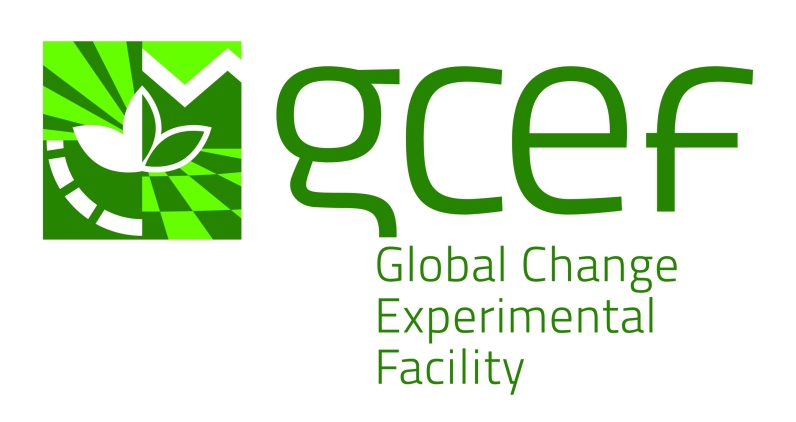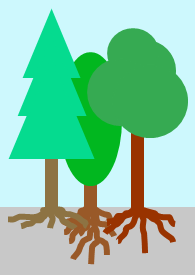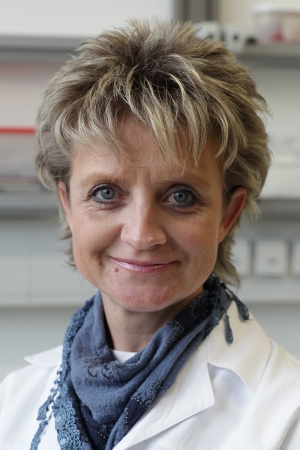Experimental Population and Community Ecology
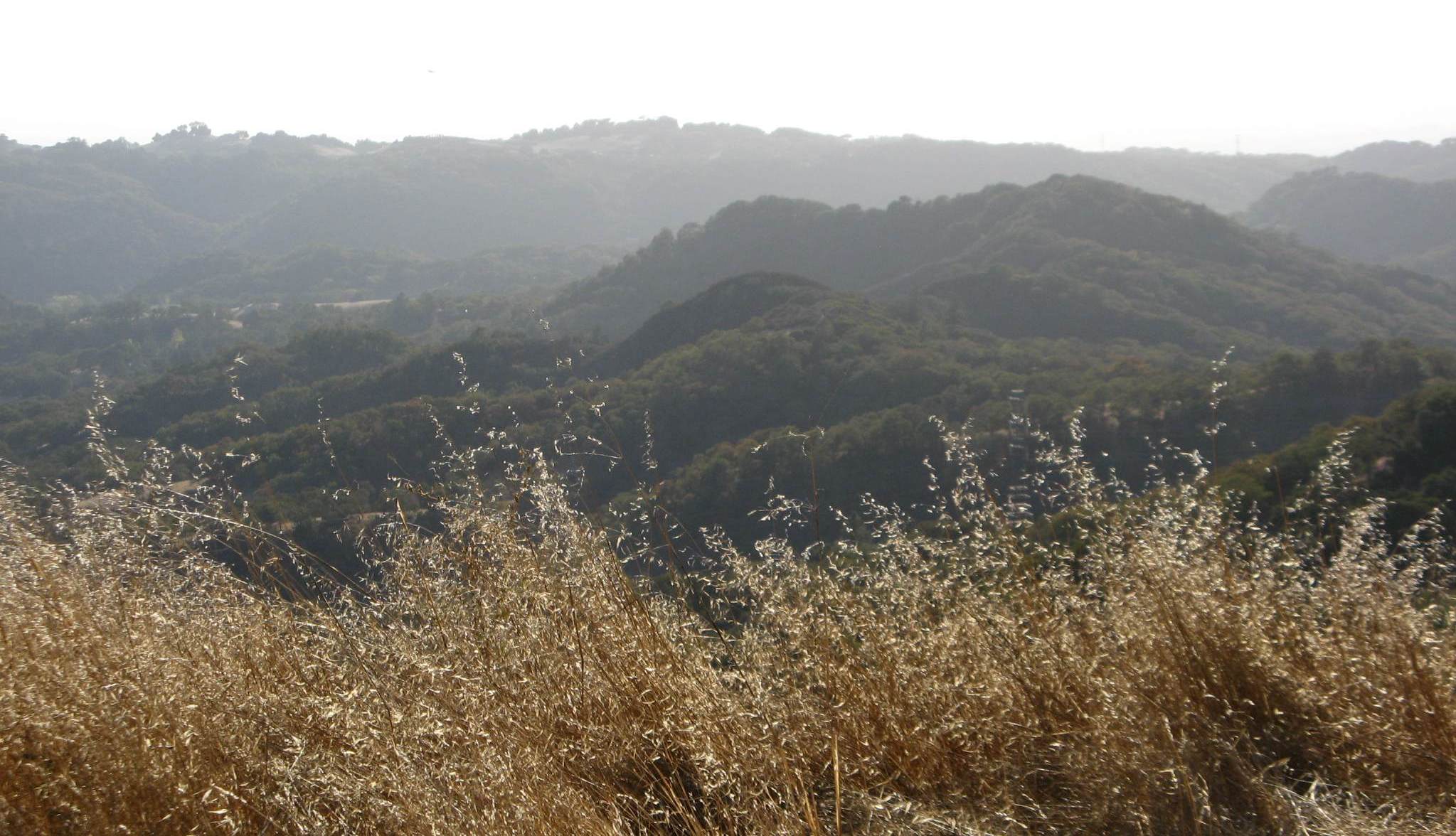
Welcome to our research group! We are plant population and community ecologists interested in a broad range of topics, including the importance of micro-evolutionary processes for ecological dynamics, and the role of ecological interactions for species coexistence and the functioning of terrestrial ecosystems. We are particularly interested in how anthropogenic drivers like land management, climate change, or invasions by exotic species influence micro-evolutionary processes and species interactions. To study these processes, we use manipulative experiments in the greenhouse, in the common garden, on experimental fields and even in real ecosystems, and employ quasi-experimental approaches that make use of existing environmental gradients across landscapes.
Rapid evolutionary change and invasive success
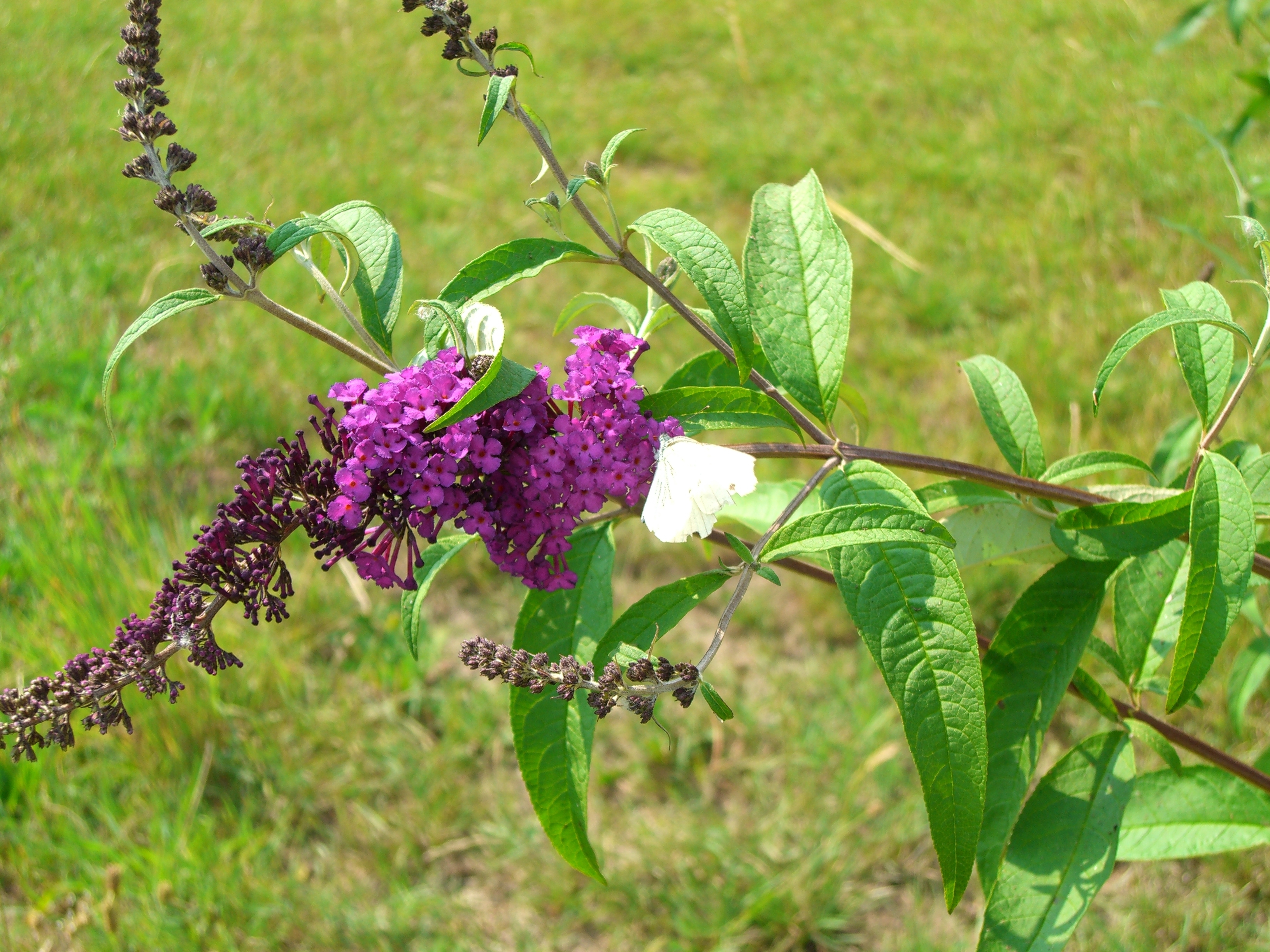 The invasive butterfly bush (Buddleja davidii) © Susanne Schreiter
The invasive butterfly bush (Buddleja davidii) © Susanne Schreiter
It has been hypothesized that one cause for the invasive success of exotic species is their potential for rapid evolutionary responses to the novel environments they encounter. However, genetic bottlenecks associated with introduction into a new geographic range may hamper adaptive evolution. We therefore investigated the role that introduction from multiple source populations and subsequent hybridization can play for creating novel genetic variation in introduced plant species (Durka et al. 2005). Besides unintentional introduction and spontaneous hybridization, both processes can also occur deliberately by plant breeding (Ross et al. 2008, Ebeling et al. 2011). If sufficient genetic variation is available as “raw material” for selection to act upon, adaptive evolution in response to varying climatic and soil conditions, or to a reduced impact of natural enemies may occur in the invaded area (Bossdorf et al. 2005). In the past, we used the invasive herb Alliaria petiolata (Bossdorf et al. 2004), and the invasive ornamental shrubs Mahonia aquifolium (Ross et al. 2008, 2009) and Buddleja davidii (Ebeling et al. al 2008, 2012) as model plants to study these relationships. More recently, we investigated the herb Ageratina adenophora, native in Central America and invasive in Asia as well as other parts of the world, as a study system (Datta et al. 2017).
Evolutionary responses to climate change and land use
Common garden experiment with Arrhenaterum elatius © Eva Völler
Rapid adaptive evolution of native plant species may buffer against the ecological impact of, e.g., changed climatic conditions or land-use intensity, thereby contributing to population persistence. Grasslands represent an important land-use type in Central Europe, harbor a large biodiversity, and are subject to changes in land-use intensity. We have therefore focussed on grassland species to investigate the importance of micro-evolutionary responses to climate and land-use change. In the past, we investigated the evolutionary potential of grassland plants in response to elevated atmospheric carbon dioxide concentrations (Wieneke et al. 2004), to climatic conditions (Weißhuhn et al. 2011, 2012), and to changed land-use intensity (Völler et al. 2013, 2017). In these projects, we collaborated with colleagues from University of Basel and University of Berne. Currently, we collaborate with the Department’s population genetic lab to study micro-evolutionary responses of grassland plants to climate change under different land-use scenarios, using the Global Change Experimental Facility (GCEF) at the UFZ Field Experimental Station in Bad Lauchstädt as an experimental platform.
Role of consumers and pathogens for plant community dynamics
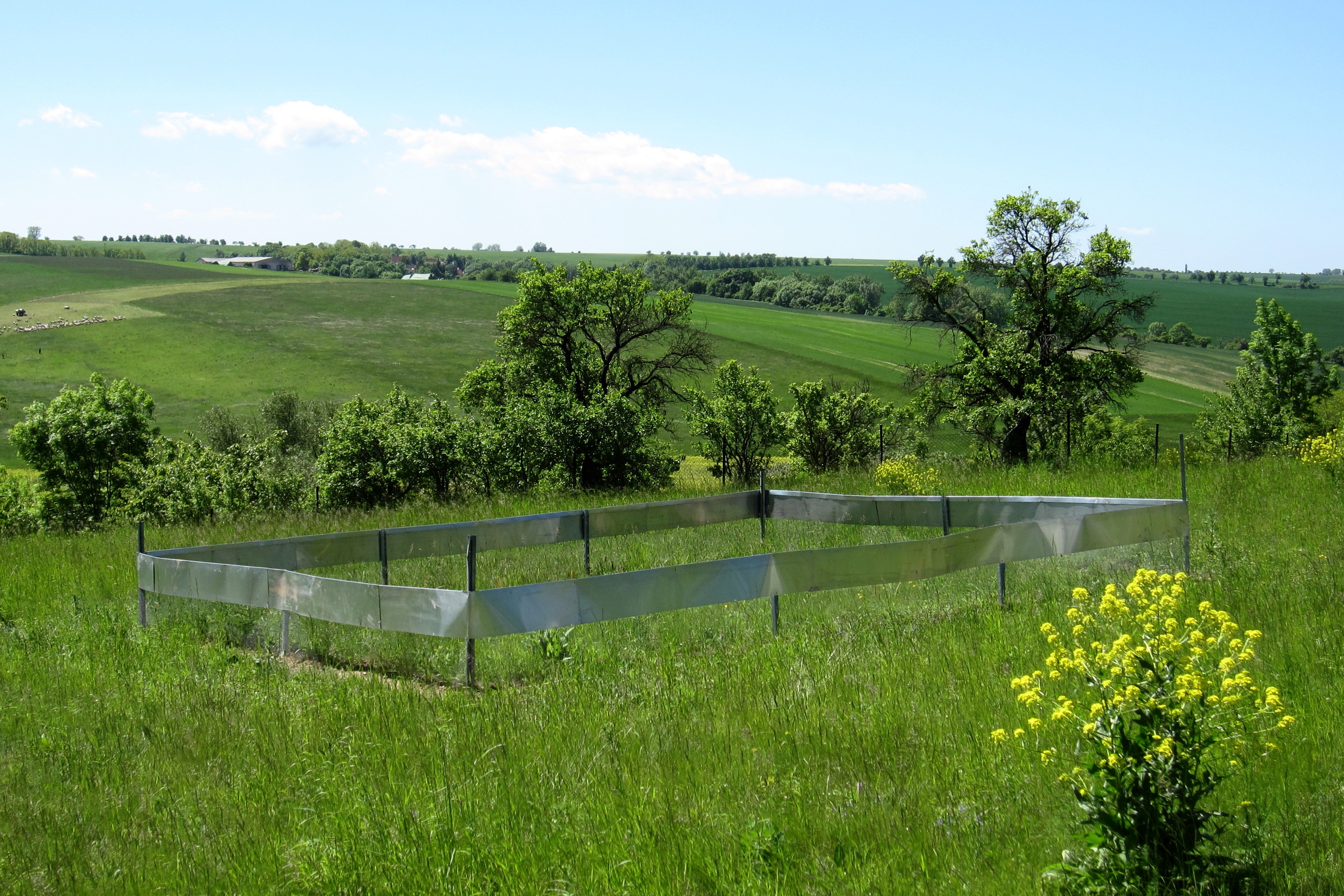 Grassland with rodent exclosure (in the foreground: the invasive perennial, Bunias orientalis)
Grassland with rodent exclosure (in the foreground: the invasive perennial, Bunias orientalis)
Another major focus of our research is on species interactions and plant community dynamics. In particular, we are interested in the role that mutualistic interactions (with mycorrhizal fungi: Stein et al. 2009) and, in particular, antagonistic interactions (with pathogens, herbivores) play for plant community dynamics, primary production and plant diversity (Schädler et al. 2003, 2004; Stein et al. 2010). How do plant antagonists mediate coexistence between plant species, and what is their importance for invasion success of exotic species? Using field and greenhouse experiments, we have studied the role that generalist herbivores such as rodents and gastropods play for plant community assembly, exotic plant invasions and primary production of grasslands (Korell et al. 2016, 2017). Currently, we explore how insect herbivores and fungal pathogens contribute to negative frequency-dependence among plant species (Schmidt et al. 2020a), as well as to plant-soil feedbacks and to priority effects in native versus exotic-dominated grassland communities. In part, these studies have been carried out together with collaborators in North America to assess the generality of results across different regions, climates and species pools (Williams et a. 2010; Maron et al. 2014; Korell et al. 2016; Schmidt et al. 2020b).
Impact of climate change and land use on grassland ecosystems
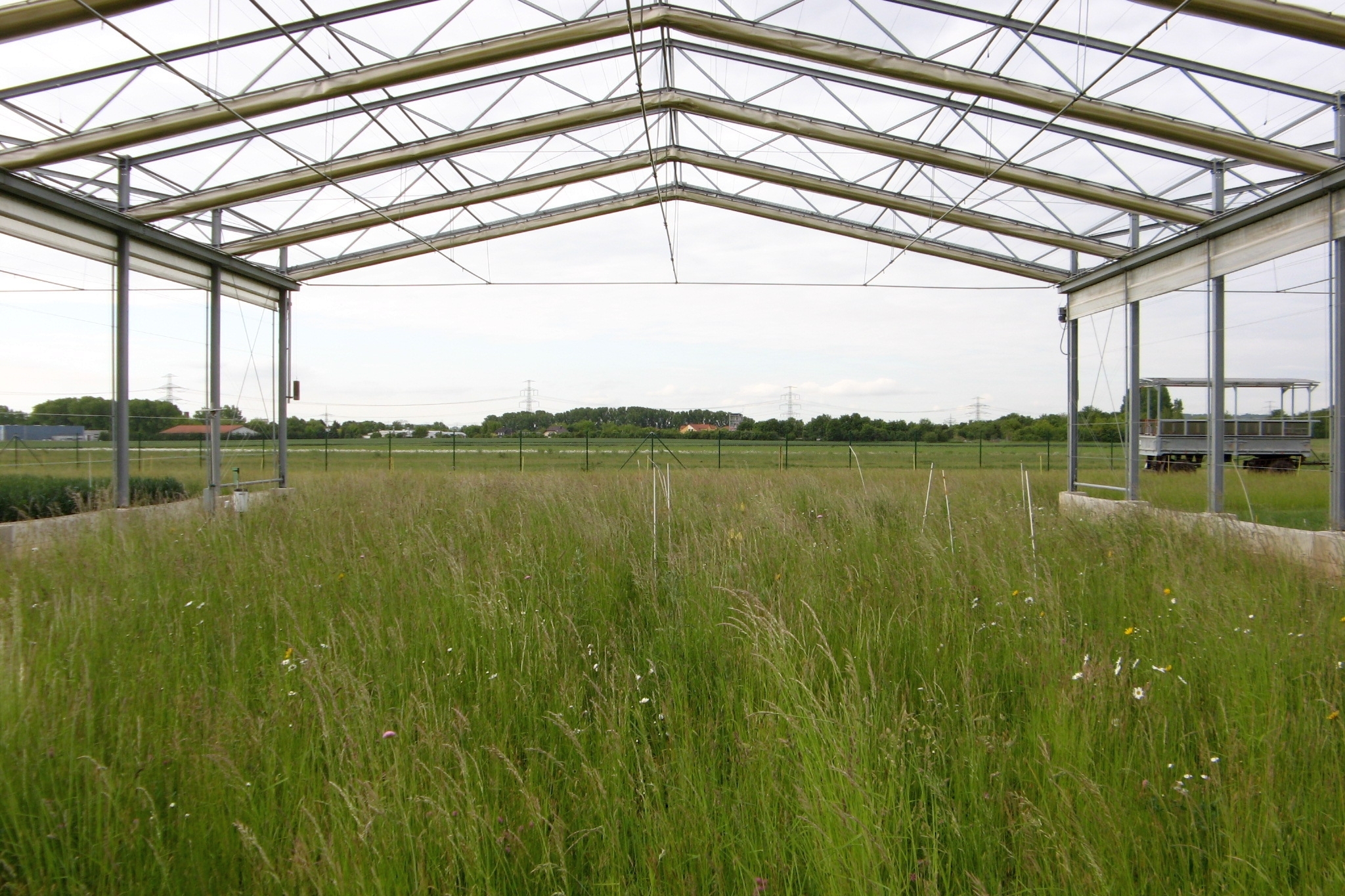 The Global Change Experimental Facility with species-rich meadow
The Global Change Experimental Facility with species-rich meadow
In newly started research projects, we are studying how man-made environmental changes impact plant community dynamics: How does species diversity, species composition and primary production of grassland communities respond to climate change under different management regimes? How are plant community responses to climate change modified, or mediated, by interactions with antagonists such as vertebrate grazers, insect herbivores and fungal pathogens? In addition, we collaborate with the Department of Physiological Diversity in a project to explore the importance of light competition for plant community responses to grazing, eutrophication and climate change (Jessen et al. 2022, 2023), and with several working groups at iDiv to synthesize experimental results on responses of plant diversity to climate change (Korell et al. 2020a,b, 2021). Many of the studies deploy the Global Change Experimental Facility (GCEF) as an experimental platform (Schädler et al. 2019; Korell et al. 2024). These studies are complemented by a DroughtNet site nearby, that is maintained in collaboration with iDiv’s Experimental Interaction Ecology (Siebert et al. 2019) and contributes to global syntheses of ecosystem responses to drought (Smith et al. 2024).
Effects of plant diversity and ecosystem functioning
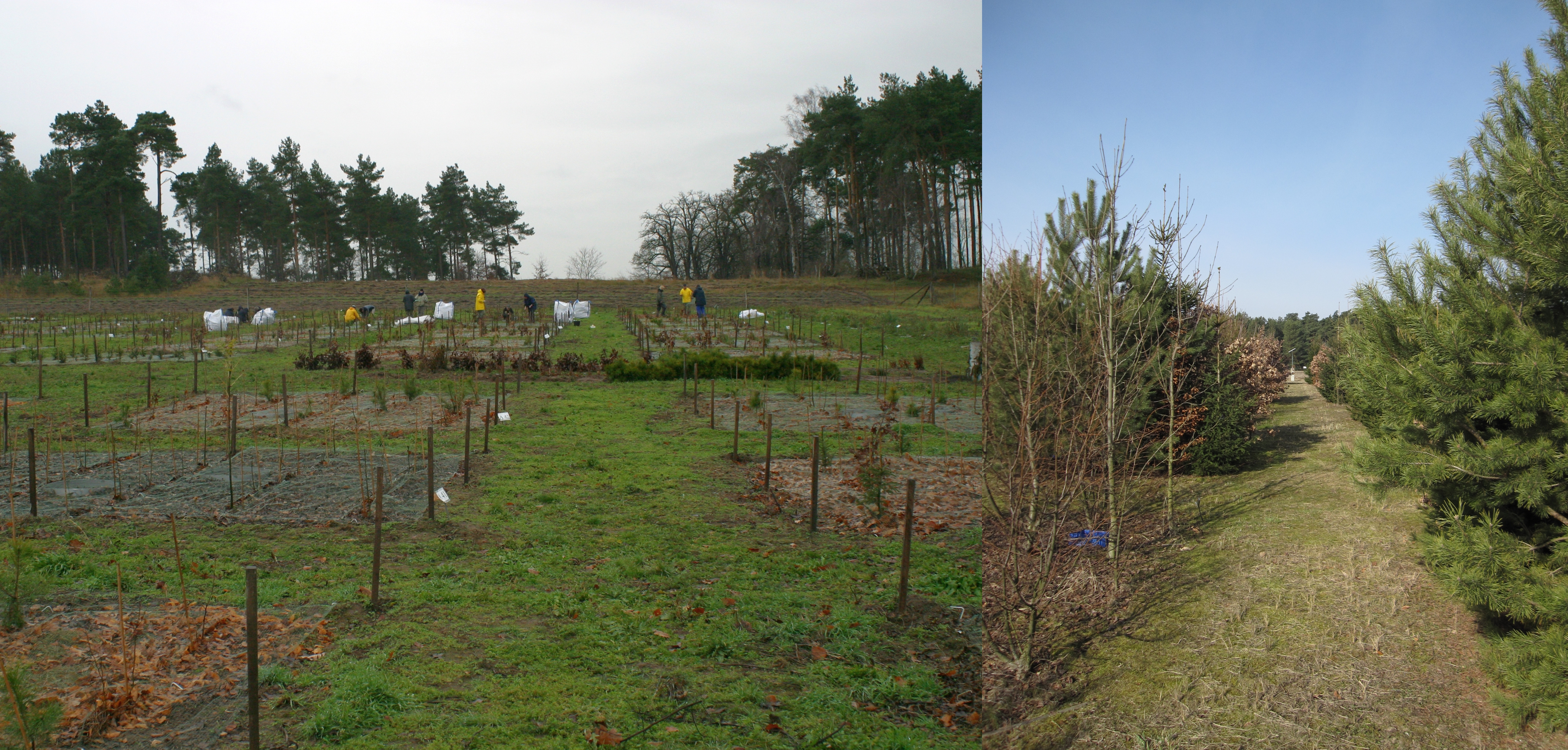 The Kreinitz Tree Diversity Experiment in 2006 (left) and 2013 (right)
The Kreinitz Tree Diversity Experiment in 2006 (left) and 2013 (right)
One of the most prominent ecological questions for the past two decades has been how biodiversity affects the functioning of ecosystems. So far, most research in this context has been done using experimental grassland ecosystems, where species richness or functional diversity is manipulated. In a complementary approach, we performed manipulative experiments in real-world ecosystems to study the importance of dispersal limitation for community assembly and ecosystem functions (Stein et al. 2008; see also Bannar-Martin et al. 2018; Ladouceur et al. 2020). Only in the 2000s, first experiments were set up to study the importance of tree species diversity for ecosystem processes. Already in 2005, we established the Kreinitz experiment to investigate how richness of native European timber species affects the functioning of temperate forest ecosystems. Together with collaborators from iDiv, University of Alberta at Edmonton, Martin-Luther University Halle, and various other institutions we are interested in diversity effects on stand productivity, on above-ground herbivory and pathogen attack, on soil microbial communities and litter decomposition, and on other ecological processes (e.g. Hantsch et al. 2014; Alalouni et al. 2014; Schwarz et al. 2015; Wurst et al. 2015; Gottschall et al. 2022, 2023; Proß et al. 2024; Shovon et al. 2024). The Kreinitz experiment is part of TreeDivNet – the global network of tree diversity experiments (Verheyen et al. 2016) – which in the meantime covers more than 30 experiments distributed across all continents (except Antarctica). TreeDivNet represents a co-ordinated, globally distributed approach that allows generalizations about the importance of tree diversity for ecosystem functioning (e.g. Paine et al. 2015; Guerrero-Ramirez et al. 2017; Djukic et al. 2018; Depauw et al. 2024).
2024
Korell L, Andrzejak M, Berger S, Durka W, Haider S, Hensen I, Herion Y, Höfner J, Kindermann L, Knight TM, Klotz S, Linstädter A, Madaj A-M, Merbach I, Michalski S, Plos C, Roscher C, Schädler M, Welk E, Auge H (2024) Land use modulates resistance of grasslands against future climate and inter-annual climate variability in a large field experiment. Global Change Biology 30: e17418. https://doi.org/10.1111/gcb.17418
Dieskau J, Hensen I, Eisenhauer N, Gaberle I, Durka W, Lachmuth S, Auge H (2024) Phylogenetic relationships and plant life stage but not biogeographic history mediate priority effects of European grassland plants. Journal of Ecology: early view. https://doi.org/10.1111/1365-2745.14373
Scherzinger F, Schädler M, Reitz T, Yin R, Auge H, Merbach I, Roscher C, Harpole S, Blagodatskaya E, Siebert J, Ciobanu M, Marder F, Eisenhauer N, Quaas M (2024) Sustainable land management enhances ecological and economic multifunctionality under ambient and future climate. Nature Communications 15: 4930. https://doi.org/10.1038/s41467-024-48830-z
Komatsu KJ, Avolio ML, Padullés Cubino J, Schrodt F, Auge H, Cavender-Bares J, Clark AT, Flores-Moreno H, Grman E, Harpole WS, Kattge J, Kimmel K, Koerner SE, Korell L, Langley JA, Münkemüller T, Ohlert T, Onstein RE, Roscher C, Soudzilovskaia NA, Taylor BN, Tedersoo L, Terry RS, Wilcox K (2024) CoRRE Trait Data: A dataset of 17 categorical and continuous traits for 4079 grassland species worldwide. Scientific Data 11: 795. https://doi.org/10.1038/s41597-024-03637-x
Plos C, Hensen I, Korell L, Auge H, Römermann C (2024) Plant species phenology differs between climate and land-use scenarios and relates to plant functional traits. Ecology and Evolution 14: e11441. https://doi.org/10.1002/ece3.11441
Shovon TA, Auge H, Haase J, Nock CA (2024) Positive effects of species diversity on productivity switch to negative after severe drought mortality in a temperate forest experiment. Global Change Biology 30: e17252. https://doi.org/10.1111/gcb.17252
Smith MD, Wilkins K, ... , Auge H, ... , Zuo X (2024) Extreme drought impacts have been underestimated in grasslands and shrublands globally. Proceedings of the National Academy of Sciences 121: e2309881120. https://doi.org/10.1073/pnas.2309881120
Zheng L, Barry K, Guerrero-Ramírez NR, Craven D, Reich PB, Verheyen K, Scherer-Lorenzen M, Eisenhauer N, Auge H, Barsoum N, Bauhus J, Binkley D, Bruelheide H, Cavender-Bares J, Dolezal J, Zhao Z, Fagundes M, Ferlian O, Fiedler S, Forrester D, Ganade G, Gebauer T, Haase J, Hajek P, Hector A, Hérault B, Hölscher D, Hulvey K, Irawan B, Jactel H, Koricheva J, Kreft H, Lanta V, Leps J, Mereu S, Messier C, Montagnini F, Mörsdorf M, Müller S, Muys B, Nock CA, Paquette A, Parker W, Parker J, Parrotta J, Paterno G, Perring M, Piotto D, Polley H, Ponette Q, Potvin C, Quosh J, Rewald B, van Ruijven J, Standish R, Stefanski A, Sundawati L, Tilman D, Urgoiti J, Williams L, Wilsey B, Yang B, Zhang L, Godbold D, Sandén H, Ebeling A, Schmid B, Fischer M, Hautier Y (2024) Effects of plant diversity on productivity strengthen over time due to trait-dependent shifts in species overyielding. Nature Communications 15: 2078. https://doi.org/10.1038/s41467-024-46355-z
Proß T, Haider S, Auge H, Bruelheide H (2024) Leaf trait variation within individuals mediates the relationship between tree species richness and productivity. Oikos 2024: e10255. https://doi.org/10.1111/oik.10255
Blondeel H, Guillemot J, Martin N, Druel A, Bilodeau-Gauthier S; Bauhus J, Grossiord C, Hector A, Jactel H, Jensen J, Messier C, Muys B, Serrano-León H, Auge H, Barsoum N, Birhane E, Bruelheide H, Cavender-Bares J, Chu C, Cumming J, Damtew A, Eisenhauer N, Ferlian O, Fiedler S, Ganade G, Godbold D, Gravel D, Hall J, Holscher D, Hulvey K, Koricheva J, Kreft H, Lapadat C, Liang J, Liu X, Meredieu C, Mereu S, Montgomery R, Morillas L, Nock C, Paquette A, Parker J, Parker W, Brant Paterno G, Perring M, Ponette Q, Potvin C, Reich P, Rentch J, Rewald B, Sandén H, Sinacore K, Standish R, Stefanski A, Tobin P, van Breugel IM, Fagundes M, Weih M, Williams L, Zhou M, Scherer-Lorenzen M, Verheyen K, Baeten L (2024) Tree diversity reduces variability in sapling survival under drought. Journal of Ecology 112: 1164-1180. https://doi.org/10.1111/1365-2745.14294
Depauw L, De Lombaerde E, Dhiedt E, Blondeel H, Barsoum N, Bauhus J, Damtew A, Eisenhauer N, Fagundes MV, Ganade G, Godbold D, Guillemot J, Hajek P, Hector A, Hérault B, Jactel H, Koricheva J, Kreft H, Mereu S, Messier C, Muys B, Paquette A, Parker WC, Patterno GB, Perring MP, Ponette Q, Potvin C, Reich P, Rewald B, Scherer-Lorenzen M, Schnabel F, Sousa-Silva R, Weih M, Zemp DC, Auge H, Gravel D, Chu C, Liu X, Verheyen K, Baeten L (2024) Enhancing tree performance through species mixing: review of a quarter-century TreeDivNet experiments revealing research gaps and practical insights. Current Forestry Reports 10: 1-20. https://doi.org/10.1007/s40725-023-00208-y1
2023
Jessen M-T, Auge H, Harpole WS, Eskelinen A (2023) Litter accumulation, but not light limitation drives plant recruitment under nutrient enrichment and grazing. Journal of Ecology 111: 1174-1187. https://doi.org/10.1111/1365-2745.14099
Gottschall F, Cesarz S, Auge H, Kovach K, Nock C, Eisenhauer N (2023) Tree community composition stabilizes ecosystem functions in response to drought. Ecosphere 14: e4486. https://doi.org/10.1002/ecs2.4486
Desie E, Zuo J, Verheyen K, Djukic I, Van Meerbeek K, Auge H, Barsoum N, Baum C, Bruelheide H, Eisenhauer N, Feldhaar H, Ferlian O, Gravel D, Jactel H, Kappel Schmidt I, Kepfer-Rojas S, Meredieu C, Mereu S, Messier C, Morillas L, Nock C, Paquette A, Ponette Q, Reich PB, Roales J, Scherer-Lorenzen M, Seitz S, Schmidt A, Stefanski A, Trogisch S, Van-Halder I, Weih M, Williams LJ, Yang B, Muys B (2023) Disentangling drivers of litter decomposition in a multi-continent network of tree diversity experiments. Science of the Total Environment 857: 159717. https://doi.org/10.1016/j.scitotenv.2022.159717
2022
Jessen MT, Auge H, Hautier Y, Harpole WS, Eskelinen A (2022) Grazing and light modify Silene latifolia responses to nutrients and future climate. PLoS ONE 17: e0276789. https://doi.org/10.1371/journal.pone.0276789
Cesarz S, Craven D, Auge H, Bruelheide H, Castagneyrol B, Gutknecht J, Hector A, Jactel H, Koricheva J, Messier C, Muys B, O’Brien MJ, Paquette A, Ponette Q, Potvin C, Reich P, Scherer-Lorenzen M, Smith A, Verheyen K, Eisenhauer N (2022) Biotic and abiotic drivers of soil microbial functions across tree diversity experiments. Global Ecology and Biogeography 31: 872-885. https://doi.org/10.1111/geb.13461
Andrzejak M, Korell L, Auge H, Knight T (2022) Effects of climate change and pollen supplementation on the reproductive success of two grassland plant species. Ecology and Evolution 12: e8501. https://doi.org/10.1002/ece3.8501
Slabbert E, Knight T, Wubet T, Kautzner A, Baeßler C, Auge H, Roscher C, Schweiger O (2022) Abiotic factors are more important than land management and biotic interactions in shaping vascular plant and soil fungal communities. Global Ecology and Conservation 33: e01960. https://doi.org/10.1016/j.gecco.2021.e01960
Gottschall F, Cesarz S, Auge H, Kovach K, Mori A, Nock C, Eisenhauer N (2022) Spatio-temporal dynamics of abiotic and biotic processes explain biodiversity-ecosystem functioning relationships. Ecological Monographs 92: e1490. https://doi.org/10.1002/ecm.1490
Messier C, Bauhus J, Sousa-Silva R, Auge H, Baeten L, Bruelheide H, Caldwell B, Cavender-Bares J, Dhiedt E, Eisenhauer N, Ganade G, Gravel D, Guillemot J, Hall JS, Hector A, Hérault B, Jactel H, Koricheva J, Kreft H, Mereu S, Muys B, Nock CA, Paquette A, Parker JD, Perring MP, Ponette Q, Potvin C, Reich PB, Scherer-Lorenzen M, Schnabel F, Verheyen K, Weih M, Wollni M, Zemp DC (2022) For the sake of resilience and multifunctionality, let’s diversify planted forests! Conservation Letters 14: e12829. https://doi.org/10.1111/conl.12829.
2021
Kambach S, Sadlowski C, Peršoh D, Guerreiro M, Auge H, Röhl O, Bruelheide H (2021) Foliar fungal endophytes in a densely planted tree diversity experiment are driven by the identity and composition but not by the diversity of the tree neighborhood. Life - Basel 11: 1081. https://doi.org/10.3390/life11101081
Korell L, Auge H, Chase J, Harpole SW, Knight T (2021) Responses of plant diversity to precipitation change are strongest at local spatial scales and in drylands. Nature Communications 12: 2489. https://doi.org/10.1038/s41467-021-22766-0.
2020
Schmidt R, Deising H, Hensen I, Schädler M, Auge H (2020) Natural enemies do not contribute to negative frequency-dependence in native and exotic grassland plants. Perspectives in Plant Ecology, Evolution and Systematics 46: 125565. https://doi.org/10.1016/j.ppees.2020.125565.
Slabbert EL, Schweiger O, Wubet T, Kautzner A, Baeßler C, Auge H, Roscher C, Knight, TM (2020) Scale-dependent impact of land management on above- and belowground biodiversity. Ecology and Evolution 10: 10139-10149. https://doi.org/10.1002/ece3.6675.
Ladouceur E, Harpole WS, Blowes SA, Roscher C, Auge H, Seabloom EW, Chase JM (2020) Reducing dispersal limitation via seed addition leads to increased species richness but not aboveground biomass. Ecology Letters 23: 1442-1450. https://doi.org/10.1111/ele.13566.
Schmidt R, Auge H, Deising HB, Hensen I, Mangan SA, Schädler M, Stein C, Knight TM (2020) Abundance, origin and phylogeny of plants do not predict community-level patterns of pathogen diversity and infection. Ecology and Evolution 10: 5506-5516. https://doi.org/10.1002/ece3.6292.
Korell L, Auge H, Chase JM, Harpole WS, Knight TM (2020) Understanding plant communities of the future requires filling knowledge gaps. Global Change Biology 26: 328-329. https://doi.org/10.1111/gcb.14920.
Korell L, Auge H, Chase JM, Harpole WS, Knight TM (2020) We need more realistic climate change experiments for understanding ecosystems of the future. Global Change Biology 26: 325-327. https://doi.org/10.1111/gcb.14797.
Kempel A, Auge H, Allen E (2020) Enemy impact on plant communities in a changing world. Preprints 2020020005.
2019
Korell L, Schädler M, Brandl R, Schreiter S, Auge H (2019) Release from above- and belowground insect herbivory mediates invasion dynamics and impact of an exotic plant. Plants 8: 544. https://doi.org/10.3390/plants8120544
Cáceres Y, Schrieber K, Lachmuth S, Auge H, Argibay D., Renison D, Hensen I (2019) Effects of altitude, land use and microsites on early-life performance of a high mountain tree: insights from an in situ sowing experiment. Diversity and Distributions 25: 1537-1550. https://doi.org/10.1111/ddi.12956
Gottschall F, Davids S, Newiger-Dous TE, Auge H, Cesarz S, Eisenhauer N (2019) Tree species identity determines wood decomposition via microclimatic effects. Ecology and Evolution 9: 12113-12127. DOI: 10.1002/ece3.5665.
Kambach S, Allan E, Bilodeau-Gauthier S, Coomes D, Haase J, Jucker T, Kunstler G, Müller S, Nock C, Paquette A, van der Plas F, Ratcliffe S, Roger F, Ruiz-Benito P, Scherer-Lorenzen M, Auge H, Bouriaud O, Castagneyrol B, Dahlgren J, Gamfeldt L, Jactel H, Kändler G, Koricheva J, Lehtonen A, Muys B, Ponette Q, Setiawan N, Van de Peer T, Verheyen K, Zavala MA, Bruelheide H (2019) How do trees respond to species mixing in experimental compared to observational studies? Ecology and Evolution 9: 11254-11265. https://doi.org/10.1002/ece3.5627.
Schädler M, Buscot F, Klotz S, Reitz T, Durka W, Bumberger J, Merbach I, Michalski S, Kirsch K, Remmler P, Schulz E, Auge H (2019) Investigating the consequences of climate change under different land-use regimes – a novel experimental infrastructure. Ecosphere 10: e02635. https://doi.org/10.1002/ecs2.2635
Pankoke H, Tewes LJ, Matthies S, Hensen I, Schädler M, Ebeling S, Auge H, Müller C (2019) Pre-adaptations and shifted chemical defences provide Buddleja davidii populations with high resistance against antagonists in the invasive range. Biological Invasions 21: 333-347
Yin R, Eisenhauer N, Auge H, Schmidt A, Schädler M (2019) Additive effects of experimental climate change and land use on faunal contribution to litter decomposition. Soil Biology and Biochemistry 131: 141-148
Siebert J, Sünnemann M, Auge H, Berger S, Cesarz S, Ciobanu M, Guerrero-Ramírez NR, Eisenhauer N (2019) The effects of drought and nutrient addition on soil organisms vary across taxonomic groups, but are constant across seasons. Scientific Reports 9: 639. https://doi.org/10.1038/s41598-018-36777-3
2018
Paquette A, Hector A, Castagneyrol B, Vanhellemont M, Koricheva J, Scherer-Lorenzen M, Verheyen K, TreeDivNet (2018) A million and more trees for science. Nature Ecology & Evolution 2: 763-766
Djukic I and 304 co-authors (2018) Early stage litter decomposition across biomes. Science of the Total Environment 628-629: 1369-1394
Bannar-Martin KH, Kremer CT, Ernest SKM, Leibold MA, Auge H, Chase J, Declerck SAJ, Eisenhauer N, Harpole S, Hillebrand H, Isbell F, Koffel T, Larsen S, Narwani A, Petermann JS, Roscher C, Cabral JS, Supp SR (2018) Integrating community assembly and biodiversity to better understand ecosystem function: the Community Assembly and the Functioning of Ecosystems (CAFE) approach. Ecology Letters 21: 167-180
2017
Datta A, Kühn I, Ahmad M, Michalski S, Auge H (2017) Processes affecting altitudinal distribution of invasive Ageratina adenophora in western Himalaya: the role of local adaptation and the importance of different life-cycle stages. PLoS ONE 12: e0187708. https://doi.org/10.1371/journal.pone.0187708
Guerrero-Ramirez NR, Craven D, Reich PB, Ewel JJ, Isbell F, Koricheva J, Parrotta JA, Auge H, Erickson HE, Forrester DI, Hector A, Joshi J, Montagnini F, Palmborg C, Piotto D, Potvin C, Roscher C, van Ruijven J, Tilman D, Wilsey B, Eisenhauer N (2017) Diversity-dependent temporal divergence of ecosystem functioning in experimental ecosystems. Nature Ecology & Evolution 1: 1639–1642
Korell L, Lang B, Hensen I, Auge H, Bruelheide H (2017) Interactions count: plant origin, herbivory and disturbance jointly explain seedling recruitment and community structure. Scientific Reports 8: 8288 https://doi.org/10.1038/s41598-017-08401-3
Völler E, Bossdorf O, Prati D, Auge H (2017) Evolutionary responses to land use in eight common grassland plants. Journal of Ecology 105: 1290-1297
Zehnsdorf A, Moeller L, Stärk H-J, Auge H, Röhl M, Stinner W (2017) The study of the variability of biomass from plants of the Elodea genus from a river in Germany over a period of two hydrological years for investigating their suitability for biogas production. Energy, Sustainability and Society 7:15. https://doi.org/10.1186/s13705-017-0117-0)
Stottmeister U, Auge H, Zerling L (2017) Flächenverbrauch und Flächenrückführung: Erfahrungen und Anregungen aus der Tagebausanierung. Abhandlungen der Sächsischen Akademie der Wissenschaften zu Leipzig – Technikwissenschaftliche Klasse. Band 1, Heft 5: 1-28.
2016
Korell L, Stein C, Hensen I, Bruelheide H, Suding KN, Auge H (2016) Stronger effect of gastropods than rodents on seedling establishment, irrespective of exotic or native plant species origin. Oikos 125: 1467-1477
Schmidt A, John K, Auge H, Brandl R, Horgan FG, Settele J, Zaitsev AS, Wolters V, Schädler M (2016) Compensatory mechanisms of litter decomposition under alternating moisture regimes in tropical rice fields. Applied Soil Ecology 107: 79-90
Korell L, Schmidt R, Bruelheide H, Hensen I, Auge H (2016) Mechanisms driving diversity-productivity relationships differ between exotic and native communities and are affected by gastropod herbivory. Oecologia 180: 1025-1036
Ampoorter E, Selvi F, Auge H, Baeten L, Berger S, Carrar Ei, Coppi A, Fotelli M, Radoglou K, Setiawan NN; Vanhellemont M, Verheyen K (2016) Driving mechanisms of overstorey-understorey diversity relationships in European forests. Perspectives in Plant Ecology, Evolution and Systematics 19: 21-29
Verheyen K, Vanhellemont M, Auge H, Baeten L, Baraloto C, Barsoum N, Bilodeau-Gauthier S, Bruelheide H, Castagneyrol B, Godbold D, Haase J, Hector A, Jactel H, Koricheva J, Loreau M, Mereu S, Messier C, Muys B, Nolet P, Paquette A, Parker J, Perring M, Ponette Q, Potvin C, Reich P, Smith A, Scherer-Lorenzen M (2016) Contributions of a global network of tree diversity experiments to sustainable forest plantations. AMBIO 45: 29-41
2015
Schmidt A, Auge H, Brandl R, Heong KL, Hotes S, Settele J, Villareal S, Schädler M (2015) Small-scale variability in the contribution of invertebrates to litter decomposition in tropical rice fields. Basic and Applied Ecology 16:674–680
Kempel A, Razanajatovo M, Stein C, Unsicker S, Auge H, Weisser WW, Fischer M, Prati D (2015) Herbivore preference drives plant community composition. Ecology 96:2923-2934
Sendek A, Herz K, Auge H, Hensen I, Klotz S (2015) Performance and responses to competition in two congeneric annual species: Does seed heteromorphism matter? Plant Biology 17:1203–1209
Schmidt A, John K, Arida G, Auge H, Brandl R, Horgan FG, Hotes S, Marquez L, Radermacher N, Settele J, Wolters V, Schädler M (2015) Short-term effects of residue management on decomposition in irrigated rice fields are not related to changes in decomposer community structure. PLoS ONE 10(7):e0134402. https://doi.org/10.1371/journal.pone.0134402
Paine CET, Amissah L, Auge H, Baraloto C, Baruffol M, Bourland N, Bruelheide H, Daînou K, de Gouvenain RC, Doucet J-L, Doust S, Fine PVA, Fortunel C, Haase J, Holl KD, Jactel H, Li X, Kitajima K, Koricheva J, Martínez-Garza C, Messier C, Paquette A, Philipson C, Piotto D, Poorter L, Posada JM, Potvin C, Rainio K, Russo SE, Ruiz-Jaen M, Scherer-Lorenzen M, Webb CO, Wright S, Zahawi RA, Hector A (2015) Globally, functional traits are weak predictors of juvenile tree growth, and we do not know why. Journal of Ecology 103:978–989
Wurst S, Kaiser N, Nitzsche S, Haase J, Auge H, Rillig MC, Powell JR (2015) Tree diversity modifies distance-dependent effects on seedling emergence but not plant-soil feedbacks of temperate trees. Ecology 96:1529-1539
Schwarz B, Dietrich C, Cesarz S, Scherer-Lorenzen M, Auge H, Eisenhauer N (2015) Non-significant tree diversity but significant identity effects on earthworm communities in three tree diversity experiments. European Journal of Soil Biology 67:17-26
Zimmer M, Auge H, von Wühlisch G, Schueler S, Haase J (2015) Environment rather than genetic background explains intraspecific variation in the protein-precipitating capacity of phenolic compounds in beech litter. Plant Ecology & Diversity 8:73-79
Winkler N, Weymann W, Auge H, Klotz S, Finkenbein P, Heilmeier H (2015) Drought resistance of native pioneer species indicates potential suitability for restoration of post-mining areas. Web Ecology 14:65-74
2014
Alalouni U, Brandl R, Auge H, Schädler M (2014) Does insect herbivory on oak depend on the diversity of tree stands? Basic and Applied Ecology 15:685-692
Hantsch L, Bien S, Radatz S, Braun U, Auge H, Bruelheide H (2014) Tree diversity and the role of non-host neighbour tree species in reducing fungal pathogen infestation. Journal of Ecology 102:1673-1687
Maron JL, Auge H, Pearson DE, Korell L, Hensen I, Suding KN, Stein C (2014) Staged invasions across disparate grasslands: effects of consumers, disturbance and seed provenance on productivity and species richness. Ecology Letters 17:499-507
Meyer K, Soldaat LL, Auge H, Thulke HH (2014) Adaptive and selective seed abortion reveals complex conditional decision making in plants. American Naturalist 183(3):376-383 (Highlighted in Science http://news.sciencemag.org/signal-noise/2014/03/plants-are-smarter-we-thought)
2013
Baeten L, Verheyen K, Wirth C, Bruelheide H, Bussotti F, Finer L, Jaroszewicz B, Selvi F, Valladares F, Allan E, Ampoorter E, Auge H, Avacariei D, Barbaro L, Barnoaiea I, Bastias CC, Bauhus J, Beinhoff C, Benavides R, Benneter A, Berger S, Berthold F, Boberg J, Bonal D, Braggernann W, Carnol M, Castagneyrol B, Charbonnier Y, Checko E, Coomes D, Coppi A, Dalmaris E, Danila G, Dawud SM, De Vries W, De Wandeler H, Deconchat M, Domisch T, Duduman G, Fischer M, Fotelli M, Gessler A, Gimeno TE, Grossiord C, Guyot V, Hantsch L, Hättenschwiler S, Hector A, Hermy M, Holland V, Jactel H, Joly FX, Jucker T, Kolb S, Koricheva J, Lexer MJ, Liebergesell M, Milligan H, Müller S, Muys B, Nguyen D, Nichiforel L, Pollastrini M, Proulx R, Rabasa S, Radoglou K, Ratcliffe S, Raulund-Rasmussen K, Seiferling I, Stenlid J, Vesterdahl L, von Wilpert K, Zavala MA, Zielinski D, Scherer-Lorenzen M (2013) A novel comparative research platform designed to determine the functional significance of forest tree diversity in Europe. Perspectives in Plant Ecology, Evolution, and Systematics 15:281-291
Völler E, Auge H, Bossdorf O, Prati D (2013) Land use causes genetic differentiation of life-history traits in Bromus hordeaceus. Global Change Biology 19:892-899
2012
Ebeling SK, Schreiter S, Hensen I, Durka W, Auge H (2012) Outcrossing breeding system does not compromise invasiveness in Buddleja davidii. Flora 207:843-848
Weißhuhn K, Prati D, Fischer M, Auge H (2012) Regional adaptation improves the performance of grassland plant communities. Basic and Applied Ecology 13:551-559
Völler E, Auge H, Prati D, Fischer M, Hemp A, Bossdorf O (2012) Geographical and land-use effects on seed-mass variation in common grassland plants. Basic and Applied Ecology 13:395-404
Walter J, Hein R, Auge H, Beierkuhnlein C, Löffler S, Reifenrath K, Schädler M, Weber M, Jentsch A (2012) How do extreme weather events and plant community composition affect host plant metabolites and herbivore performance? Arthropod-Plant Interactions 6:15-25
2011
Weißhuhn K, Auge H, Prati D (2011) Geographic variation in the response to drought in nine grassland species. Basic and Applied Ecology 12:21-28
Ebeling SK, Stöcklin J, Hensen I, Auge H (2011) Multiple common gardens suggest lack of local adaptation in an invasive ornamental plant. Journal of Plant Ecology 4: 209–220
Schreiter S, Ebeling SK, Durka W (2011) Polymorphic microsatellite markers in the invasive shrub Buddleja davidii (Scrophulariaceae). American Journal of Botany 98:e39-e40
Williamson M, Meyerson LA, Auge H (2011) Invasion science, ecology and economics: seeking roads not taken. NeoBiota 10:1-5. doi:10.3897/neobiota. 10.2194
2010
Stein C, Unsicker S, Kahmen A, Wagner M, Audorff V, Auge H, Prati D, Weisser WW (2010) Impact of invertebrate herbivory in grasslands depends on plant species diversity. Ecology 91:1639-1650 (Highlighted in Science 329 (2010) 258)
Williams J, Auge H, Maron J (2010) Testing hypotheses for exotic plant success: parallel experiments in the native and introduced range. Ecology 91:1355-1366
Auge H, Prati D, Stein C (2010) Der Zusammenhang zwischen Produktivität und Bodiversität. In: Hotes S, Wolters V (eds): Fokus Biodiversität. Wie Biodiversität in der Kulturlandschaft erhalten und nachhaltig genutzt werden kann. München: Oekom Verlag. 90-99.
2009
Weißhuhn K, Prati D (2009) Activated carbon may have undesired side effects for testing allelopathy in invasive plants. Basic and Applied Ecology 10:500-507
Seppelt R, Kühn I, Klotz S, Frank K, Schloter M, Auge H, Kabisch S, Görg C, Jax K (2009): Land use options - strategies and adaptation to global change. Gaia – Ecological Perspectives for Science and Society 18:77-80
Hempel S, Stein C, Unsicker SB, Renker C, Auge H, Weisser WW, Buscot F (2009) Specific bottom-up effects of arbuscular mycorrhizal fungi across a plant-herbivore-parasitoid system. Oecologia 160:267-277
Stein C, Rißmann C, Hempel S, Renker C, Buscot F, Prati D, Auge H (2009) Interactive effects of mycorrhizae and a hemiparasite on plant community productivity and diversity. Oecologia 159:191-205
Ross CA, Faust D, Auge H (2009) Mahonia invasions in different habitats: local adaptation or general-purpose genotypes? Biological Invasions 11:441-452
Bossdorf O, Pigliucci M (2009) Plasticity to wind is modular and genetically variable in Arabidopsis thaliana Evolutionary Ecology 23:669-685
2008
Ebeling SK, Welk E, Auge H, Bruelheide H (2008) Predicting the spread of an invasive plant: Combining experiments and ecological niche models. Ecography 31:709-719
Ross CA, Auge H, Durka W (2008) Genetic relationships among three native North-American Mahonia species, invasive Mahonia populations from Europe, and commercial cultivars. Plant Systematics and Evolution 275:219-229
Stein C, Auge H, Fischer M, Weisser WW, Prati D (2008) Dispersal and seed limitation affect diversity and productivity of montane grasslands. Oikos 117:1469-1478
Williams J, Auge H, Maron J (2008) Different gardens, different results: Native and introduced populations exhibit contrasting phenotypes across common gardens. Oecologia 157:239-248
Ross CA, Auge H (2008) Invasive Mahonia plants outgrow their native relatives. Plant Ecology 199:21-31
Ebeling SK, Hensen I, Auge H (2008) The invasive shrub Buddleja davidii Franch. performs better in its introduced range. Diversity and Distributions 14:225-233
Boßdorf O, Lipowsky A, Prati D (2008) Selection of preadapted populations allowed Senecio inaequidens to invade Central Europe. Diversity and Distributions 14:676-685
Boßdorf O, Richards CL, Pigliucci M (2008) Epigenetics for ecologists. Ecology Letters 11:106-115
2007
Feng Y-L, Auge H, Ebeling SK (2007) Invasive Buddleja davidii allocates more nitrogen to its photosynthetic machinery than five native woody species. Oecologia 153:501-510
2006
Stinson KA, Campbell SA, Powell JR, Wolfe BE, Callaway RM, Thelen GC, Hallett SG, Prati D, Klironomos JN (2006) Invasive plant suppresses the growth of native tree seedlings by disrupting belowground mutualisms. PLoS Biology 4:e140
Richards CL, Boßdorf O, Muth NZ, Gurevitch J, Pigliucci M (2006) Jack of all trades, master of some? On the role of phenotypic plasticity in plant invasions. Ecology Letters 9:981-993
Roß C, Durka W (2006) Isolation and characterization of microsatellite markers in the invasive shrub Mahonia aquifolium (Berberidaceae) and their applicability in related species. Molecular Ecology Notes 6:948-950
2005
Bossdorf O, Auge H, Lafuma L, Rogers WE, Sieman E, Prati D (2005) Phenotypic and genetic differentiation in native versus introduced plant populations. Oecologia 144:1-11
Bischoff A, Auge H, Mahn E-G (2005) Seasonal changes of the relationship between plant species richness and community biomass in early succession. Basic and Applied Ecology 6:385-394
Durka W, Bossdorf O, Prati D, Auge H (2005) Molecular evidence for multiple introductions of invasive garlic mustard (Alliaria petiolata, Brassicaceae) to North America. Molecular Ecology 14:1697-1706
2004
Bossdorf O, Prati D, Auge H, Schmid B (2004) Reduced competitive ability in an invasive plant. Ecology Letters 7:346-353
Schädler M, Alphei J, Scheu S, Brandl R, Auge H (2004) Resource dynamics in an early-successional plant community is influenced by insect exclusion. Soil Biology & Biochemistry 36:1817-1826
Bossdorf O, Schröder S, Prati D, Auge H (2004) Palatability and tolerance to simulated herbivory in native and introduced populations of garlic mustard (Alliaria petiolata). American Journal of Botany 91:856-862
Wieneke S, Prati D, Brandl R, Stöcklin J, Auge H (2004) Genetic variation in Sanguisorba minor after 6 years in situ selection under elevated CO2. Global Change Biology 10:1389–1401
Schädler M, Jung G, Brandl R, Auge H (2004) Secondary succession is influenced by belowground insect herbivory on a productive site. Oecologia 138:242-252
Prati D, Boßdorf O (2004) Allelopathic inhibition of germination by Alliaria petiolata (Brassicaceae). American Journal of Botany 91:285-288
Durka W, Bossdorf O, Gautschi B (2004) Isolation and characterization of microsatellite loci in the invasive Alliaria petiolata (Brassicaceae). Molecular Ecology Notes 4:173-175
Prati D, Boßdorf O (2004) A comparison of native and introduced populations of the South African Ragwort Senecio inaequidens DC. in the field. In: Breckle SW, Schweizer B, Fangmeier A (eds) Results of worldwide ecological studies. Proceedings of the 2nd Symposium of the A.F.W.Schimper Foundation. Verlag G. Heimbach, Stuttgart. 353-359.
2003
Schädler M, Jung G, Auge H, Brandl R (2003) Palatability, decomposition and insect herbivory: patterns in a successional old-field plant community. Oikos 103:121-132
Schädler M, Jung G, Auge H, Brandl R (2003) Does the Fretwell-Oksanen model apply to invertebrates? Oikos 100:203-207
2001
Auge H, Neuffer B, Erlinghagen F, Grupe R, Brandl R (2001) Demographic and RAPD analyses reveal high levels of genetic diversity in a clonal violet. Molecular Ecology 10:1811-1819
Stoll P, Prati D (2001): Intraspecific aggregation alters competitive interactions in experimental plant communities. Ecology 82:319-327
Brändle M, Amarell U, Auge H, Klotz S, Brandl R (2001) Plant and insect diversity along a pollution gradient: understanding species richness across trophic levels. Biodiversity and Conservation 10:1497-1511
Frenzel M, Soldaat LL, Auge H (2001) Successful colonisation of a new host by a specialised phytophagous insect: Does enemy escape play a role? Mitteilungen der Deutschen Gesellschaft für Allgemeine und Angewandte Entomologie 13:57-60
Brandl R, Klotz S, Stadler J, Auge H (2001) Nischen, Lebensgemeinschaften und biologische Invasionen. Rundgespräche der Kommission für Ökologie, Bayerische Akademie der Wissenschaften, Bd. 22 „Gebietsfremde Arten, die Ökologie und der Naturschutz“. 81-98.
Auge H, Klotz S, Prati D, Brandl R (2001) Die Dynamik von Pflanzeninvasionen: ein Spiegel grundlegender ökologischer und evolutionsbiologischer Prozesse. Rundgespräche der Kommission für Ökologie, Bayerische Akademie der Wissenschaften, Bd. 22 „Gebietsfremde Arten, die Ökologie und der Naturschutz“. 41-58.
2000 and earlier
Jung G, Schädler M, Auge H, Brandl R (2000) Effects of herbivorous insects on secondary plant succession. Mitteilungen der Deutschen Gesellschaft für Allgemeine und Angewandte Entomologie 12:169-173
Neuffer B, Auge H, Mesch H, Amarell U, Brandl R (1999) Spread of violets in polluted pine forests: Morphological and molecular evidence for the ecological importance of interspecific hybridization. Molecular Ecology 8:365-377
Soldaat LL, Auge H (1998) Interactions between an invasive plant, Mahonia aquifolium, and a native phytophagous insect, Rhagoletis meigenii. In: Starfinger U, Edwards K, Kowarik I, Williamson M (eds): Plant Invasions: Ecological Mechanisms and Human Responses. Leiden: Backhuys Publishers. 347-360.
Auge H, Brandl R (1997) Seedling recruitment in the invasive clonal shrub, Mahonia aquifolium. Oecologia 110:205-211
Auge H, Brandl R, Fussy M (1997) Phenotypic variation, herbivory and fungal infection in the clonal shrub Mahonia aquifolium (Berberidaceae). Mitteilungen der Deutschen Gesellschaft für Allgemeine und Angewandte Entomologie 11:747-750
Feldmann R, Henle K, Auge H, Flachowsky J, Klotz S, Krönert R (eds) (1997) Regeneration und nachhaltige Landnutzung: Konzepte für belastete Regionen. Berlin, Heidelberg, New York: Springer.
Amarell U, Auge H (1997) Der Naturpark Dübener Heide: Nutzungsgeschichte und Problemstellung. In: Feldmann R, Henle K, Auge H, Flachowsky J, Klotz S, Krönert R (eds) Regeneration und nachhaltige Landnutzung: Konzepte für belastete Regionen. Berlin, Heidelberg, New York: Springer. 87-90.
Auge H (1997) Biologische Invasionen: Das Beispiel Mahonia aquifolium. In: Feldmann R, Henle K, Auge H, Flachowsky J, Klotz S, Krönert R (eds) Regeneration und nachhaltige Landnutzung: Konzepte für belastete Regionen. Berlin, Heidelberg, New York: Springer. 124-129.
Auge H (1997) Anthropogene Belastungen und Regenerationspotentiale im Naturpark Dübener Heide. In: Feldmann R, Henle K, Auge H, Flachowsky J, Klotz S, Krönert R (eds) Regeneration und nachhaltige Landnutzung: Konzepte für belastete Regionen. Berlin, Heidelberg, New York: Springer. 149-151.

